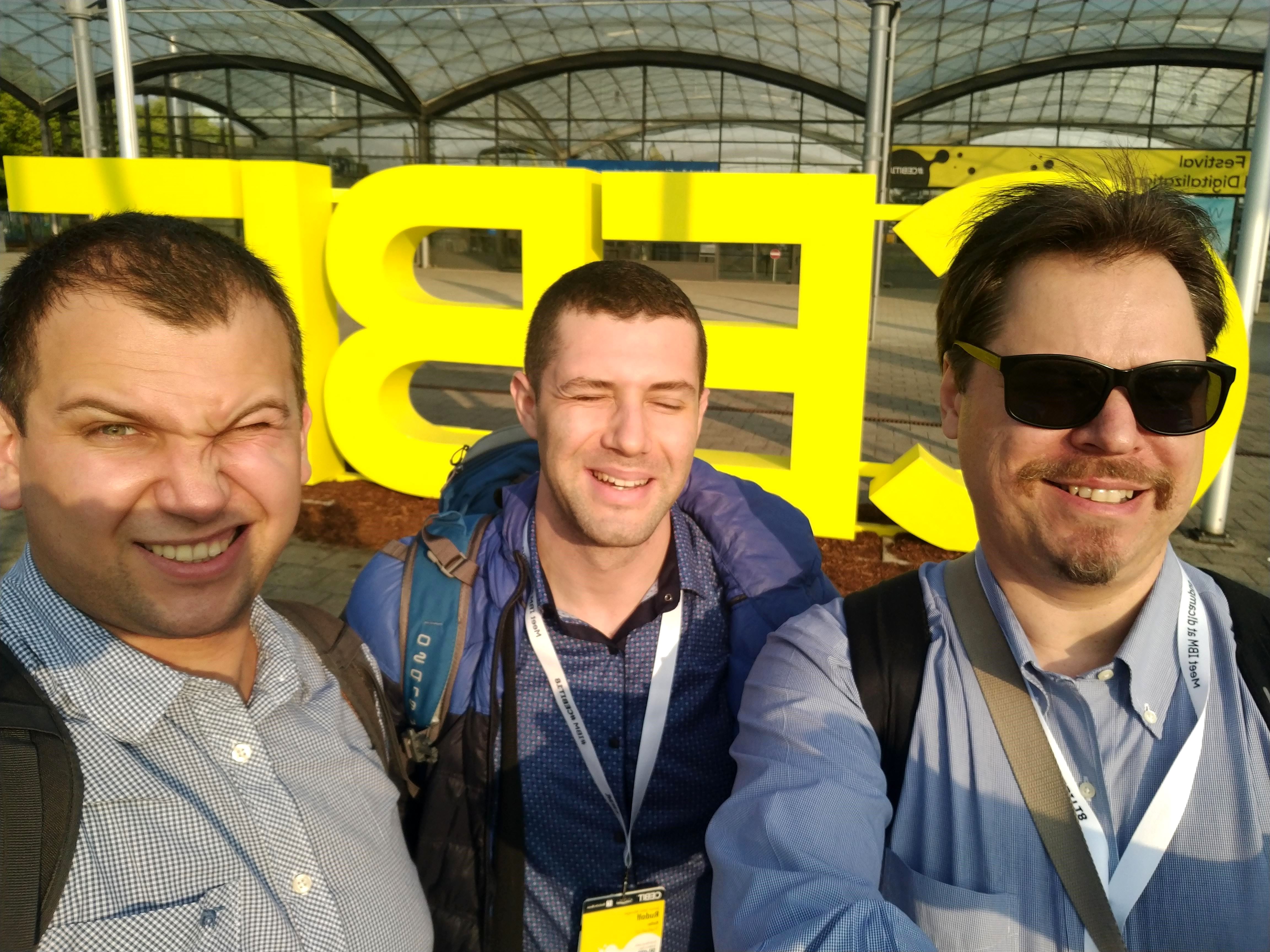
Further there will be reflections, proven recipes and pitfalls. Over the past years, we have traveled about 15 or more such major events as ISE, CeBIT, InfoComm, GITEX, Enterprise Connect. In this troubled time, I would like to share with you the experience I have accumulated, sooner or later it will be useful to many domestic IT companies interested in exporting their solutions.
- Why go to exhibitions at all
- Choosing an exhibition
- Planning expenses
- It is important to choose the right place
- Design and construction of the stand
- More subtleties to note
- We
are going - Profit Is
it all or not yet? After the cancellation in Barcelona at the end of February of the Mobile World Congress (MWC 2020) on the media space, along with the misery of lost money, there was some sigh of relief. Exhibitions - the last stronghold of offline communications, which so far no one has been able to crush - fell under the onslaught of the coronavirus.
Some quickly mobilized and carried out all the planned activities online. But even now, almost a year after the beginning of the epidemic, the situation is very unstable and we will not see a single large IT or AV exhibition this year.
Isn't everything going to be online now? Online is more convenient if you are already known offline. For example, if you are Sberbank or Yandex. For a whole year, everyone is just waiting to start catching your every word and broadcast it to the whole world. But it is not in vain that event organizers have been building a reputation for their events for years so that the whole color of the industry flocks to them and even a modest manufacturer has a chance to be noticed.
The exhibition industry is not sitting idly by now, asking for support from governments and developing ways out of the crisis, trying to dissociate itself from the term "mass event". At the moment, the planning horizon in the industry has shifted to the summer of 2021. CES 2021 will take place entirely online early next year. The organizers of ISE 2021 still hope to hold the exhibition offline, but not in February, but in June. MWC 2021 was also pushed back to June. And this may not be the last transfer of these events.
In general, now it is difficult to predict when large exhibitions and trade shows will return to us and whether their attendance will recover after the epidemic. Air travel is limited, exhibitors are reluctant to invest in shows with a potentially small number of visitors, while funds and preparation time are needed as much as in the good old dock days.
However, for many, an exhibition is a status event like a cool party. The very place where new acquaintances are made, questions are resolved. Online, of course, is cheaper, but not that. The notorious networking as one of the most valuable components still holds the defense against video communication. As soon as life gets better, new rules of interaction and cultural codes are settled, the regulars of the exhibitions will return to their usual ways of doing business. For something to change dramatically, you probably need to wait for a couple of generations to retire. In general, you still have time to use this channel and stand with a stand somewhere abroad.
Why go to exhibitions at all
For example, you have reached the point when your products are good enough for export and you want and can expand your sales, enter new markets. How to attract foreign clients and get into the reviews of specialized resources?
Concentration of the right people . Selling personally to every consumer and journalist is not an option, and the carpet bombardment of the information field with advertising is more likely to irritate people. It is necessary to look for places of concentration of professionals, and these are good old non-original exhibitions.
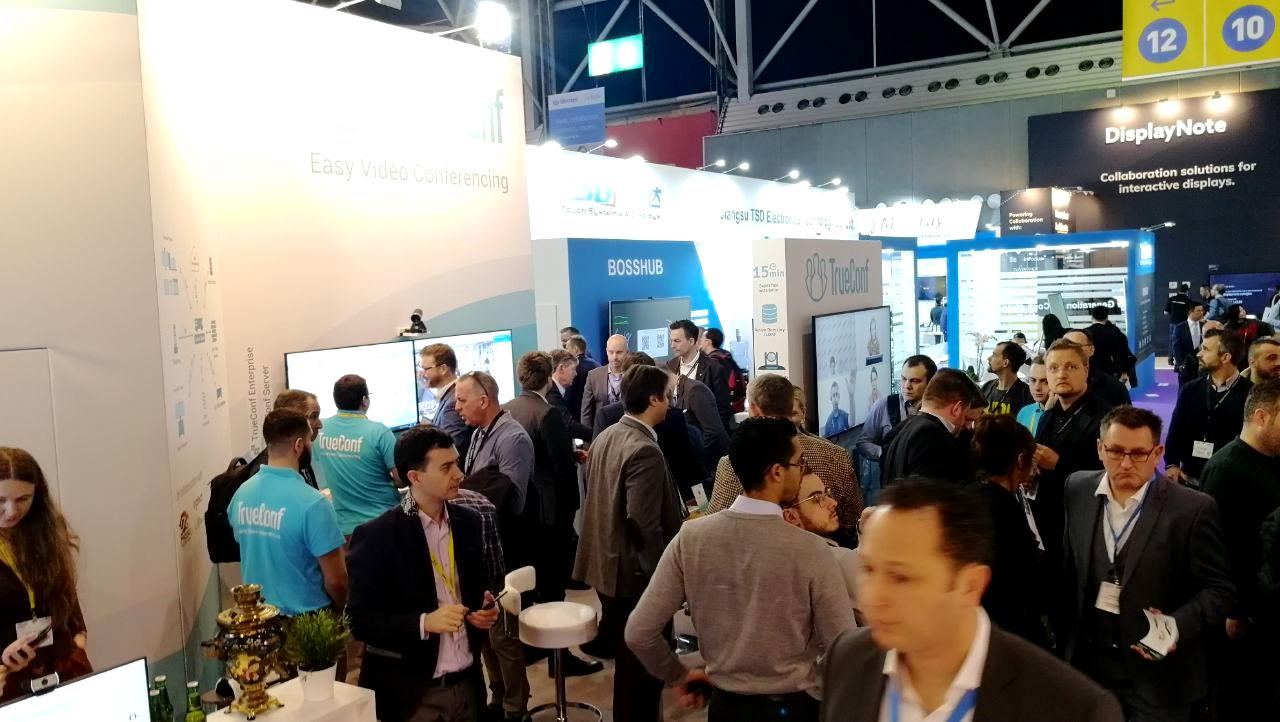
Readiness of the right people... You can search for partners in the network separately and present your product. But in this case, you lose the chance to take the person out of context, the likelihood of a successful outcome decreases. Your product will be like regular courses and articles that you really want to study and read, and then just clear all the bookmarks at once, because as long as possible. The organizers have lured the right people to the exhibition, who are not busy with anything other than studying new products and READY to watch and listen at their own will.
Demonstration opportunities . If you have a product for communication via the Internet, then it is convenient to demonstrate it via the Internet, and if it is a wonderful multifunctional entertainment center for the home, then it is much more difficult to impress via the Internet. The exhibition is an immersion + almost a personal presentation in terms of the degree of involvement.
The main goal, in our experience, is to personally get acquainted with as many professionals, partners, journalists, analysts as possible. And show them our software and solutions live. There is little chance of finding clients at the exhibition, at least this has never happened before in B2B. It is better to leave evenings for very important negotiations, there will be 3-4 of them in total and you do not need a stand for them. Therefore, the main task is to demonstrate the product and meet at the stand.
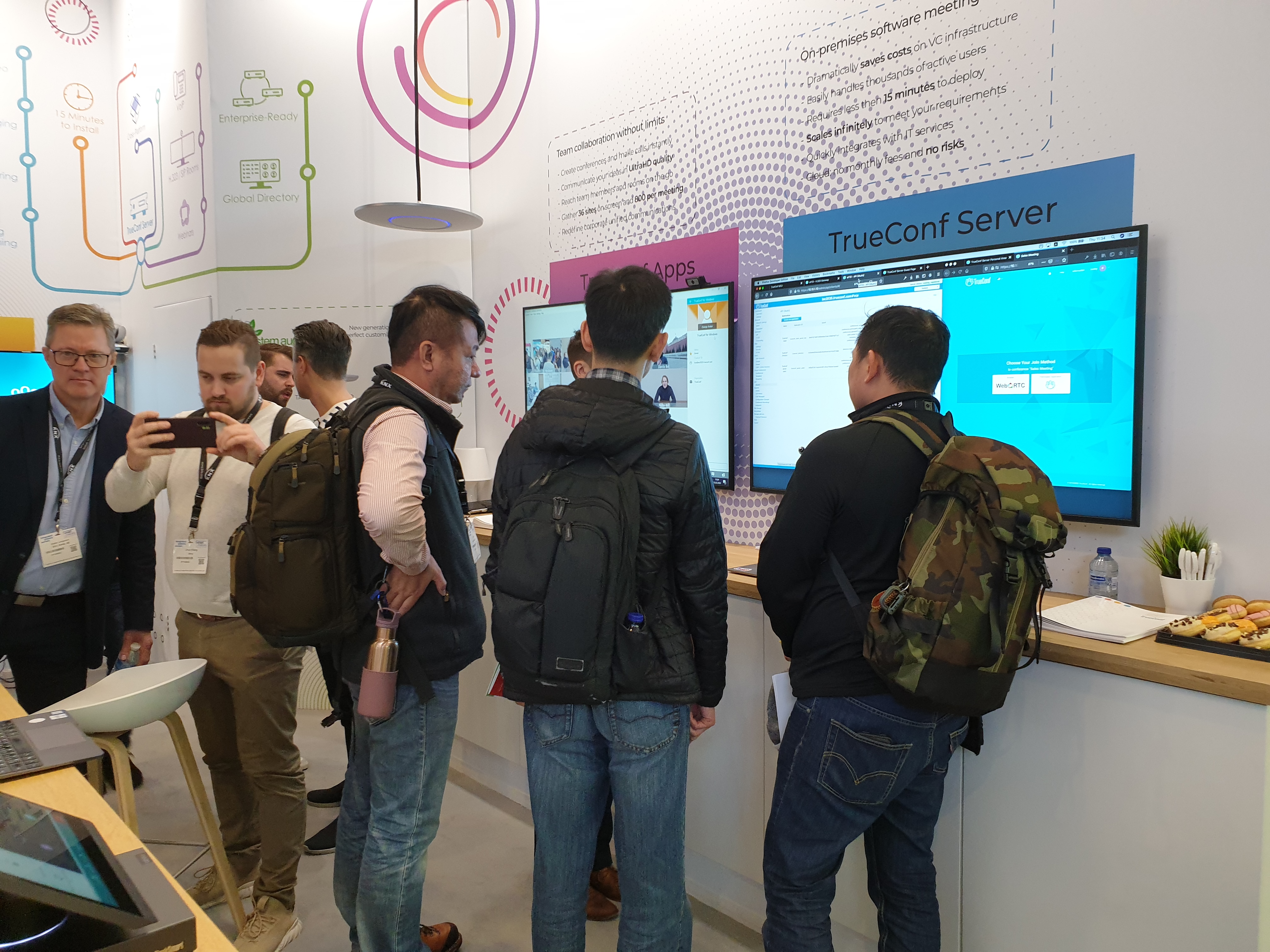
You shouldn't sort people into useful and useless at a specialized exhibition, the organizers have already sorted them for you. Anyone passing by with a high degree of probability can be of some use to you, he just does not know about it yet. No matter how interested he pretends to be, grab everyone. And here the winner is always the one who behaves more actively and whose stand is more attractive.
Choosing an exhibition
You need to decide which exhibition you want to go to and why. In general, you are looking for those who can (a) sell your product further and (b) tell about it to as many potential buyers as possible.
It is more logical and simpler to evaluate exhibitions by who the product is intended for. For enterprises - b2b, individuals - b2c. In the second case, retail representatives, as well as journalists and various opinion leaders, who will then “sell” you in the form of information to a large audience, act as the buyer. We are not considering trade fairs where the goal is to sell to the end customer, it only works when the margin for the goods sold (and ideally per unit of goods) covers all the costs of the exhibition at once. In this case, you must have a Boeing with you, or at least a Kamaz.
For example, ISE (Integrated Systems Europe) is for AV industry professionals. MWC (Mobile World Congress) is more for end buyers and electronics users, Enterprise Connect for video conferencing and telephony professionals. All this can be gleaned from the exhibition websites, as well as from last year's exhibitor lists.
We plan expenses
It is better to prepare for the exhibition strongly in advance - at least six months in advance. This will give you the opportunity to choose a good location. For example, at ISE, the battle for seats for the next year starts right during the exhibition, there is a booking queue and a point system that gives advantages. Not everyone can have time to choose a place to their liking. In addition, development planning takes a lot of time, and the stand often needs to be handed over for review and approval by the organizers several months before the event.
If you are visiting the exhibition for the first time, take no more than
 Our small booth at CeBIT
Our small booth at CeBIT
What is the budget for:
- The price per square meter multiplied by their number - the so-called raw space, that is, bare space.
- Stand production and building.
- Services: electricity, internet, guest treats (so-called catering), equipment rental. Internet is very expensive, good speed is rare, better get ready for offline demos right away.
- Business cards, promotional materials, gifts.
- Delivery, accommodation and feeding yourself loved ones before, after and during the event.
On point 5: expenses for yourself very much depend on how many of you, what level of comfort you prefer, and when you manage to book everything. For example, in Europe, on average, you need to keep in mind the amount of about € 2000 per person per working week, including food, hotels and flights.
The later you start preparing for the show, the more expensive it is, and sometimes it is completely unrealistic. If it is only 3 months before a big exhibition, you often have to fly to a neighboring city, state and even a neighboring country and from there go by train or in a rented car, because there are no direct flights.
Make sure that you do not have to spend 2 hours driving from the hotel, that there are convenient public transport nearby. The taxi will be in a coma; you shouldn't count on it. Better to take a hotel with breakfast, saving time is much more important than saving money. At 8 am, you already need to be on the site and prepare to receive guests. As an option, a room in a hostel can help out for the whole company, if there is nothing left.
Here are some numbers for points 1-4 for example:
| ISE 2018, 22 m 2 , € | CeBIT 2018, 12 m 2 , € | |
|---|---|---|
| 1. Area | 8624 | 6357 |
| 2. Booth design and building | 6969 | included in the amount above |
| 3. Electricity, monitor rental, services, catering | 2038 | 1417 |
| 4. Printing and gifts | 757 | 561 |
Total |
18388 | 8335 |
Price per m 2 |
835 / m 2 | 694 / m 2 |
That is, very roughly with the travel expenses, the amount is obtained from 1 million rubles per event. In the US, everything has to be multiplied by 1.5. There are peculiarities of pricing for services due to trade unions and strict regulation. Every sneeze has its own certified specialist, without whom you have no right to plug an extension cord into an outlet or carry a TV out of the parking lot.
PS If you are an exporter and your exhibition is large enough, there is an option that the Russian Export Center will be able to reimburse you part of the costs for it. Submit your application on the official website of RECfrom the legal entity of the company, get ready to fill out many different questionnaires and be patient. But don't get your hopes up, on closer inspection this may not be the best deal. You can also see what the Moscow Export Center offers. If you are from the capital, we highly recommend it. Sometimes regional authorities take them to foreign exhibitions absolutely free of charge, ask in your city.
 Novosibirsk Region booth at CeBIT 2018
Novosibirsk Region booth at CeBIT 2018
Choosing the right place is important
You must stand in a stream or in crowded places. Ideally - on the route from / to famous anchor exhibitors, which everyone will come to see, but that’s how lucky. It's good if you can be seen from such a steep stand from afar along the aisle. To do this, you can hang such a structure over the stand (pictured below). It cost about $ 1500 for everything: rent of suspension points, construction, printing and the work of installers.
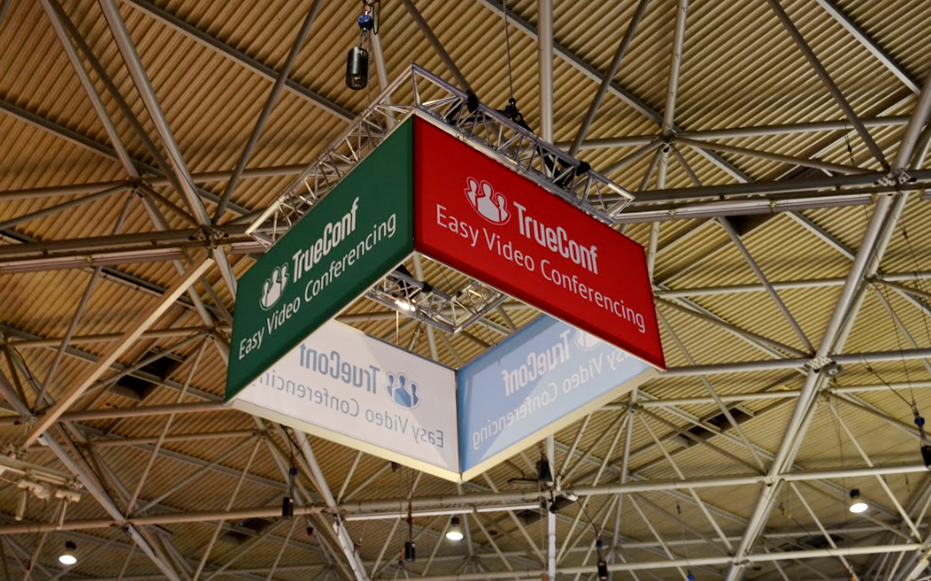
Do not be afraid of walkways to toilets, cafeterias or places near them. Potential partners are also people and the flow there is constant.
There are "danger zones". These are all sorts of industry and state stands, where they show the stormy administrative activity. They go there only out of despair. If there is a choice, at European exhibitions it is better to distance yourself from little-known Asian brands, especially Chinese pavilions.
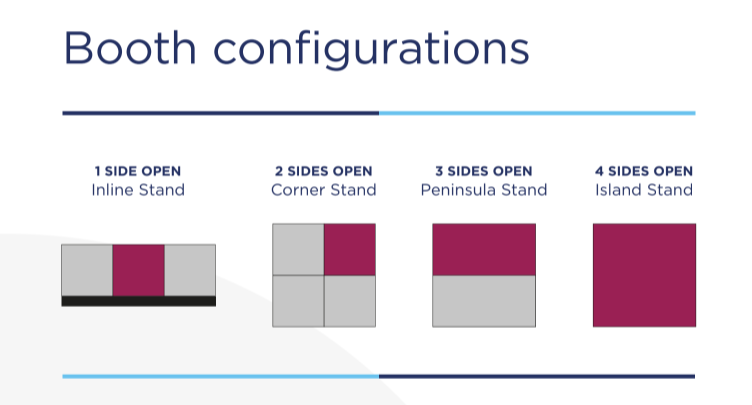
In our experience, from the point of view of construction, the best stand is an open stand of the “island” type, which can be approached from any side, or even better, a shortcut through it. But the organizers are vigilant. Open island stands are rarely less than
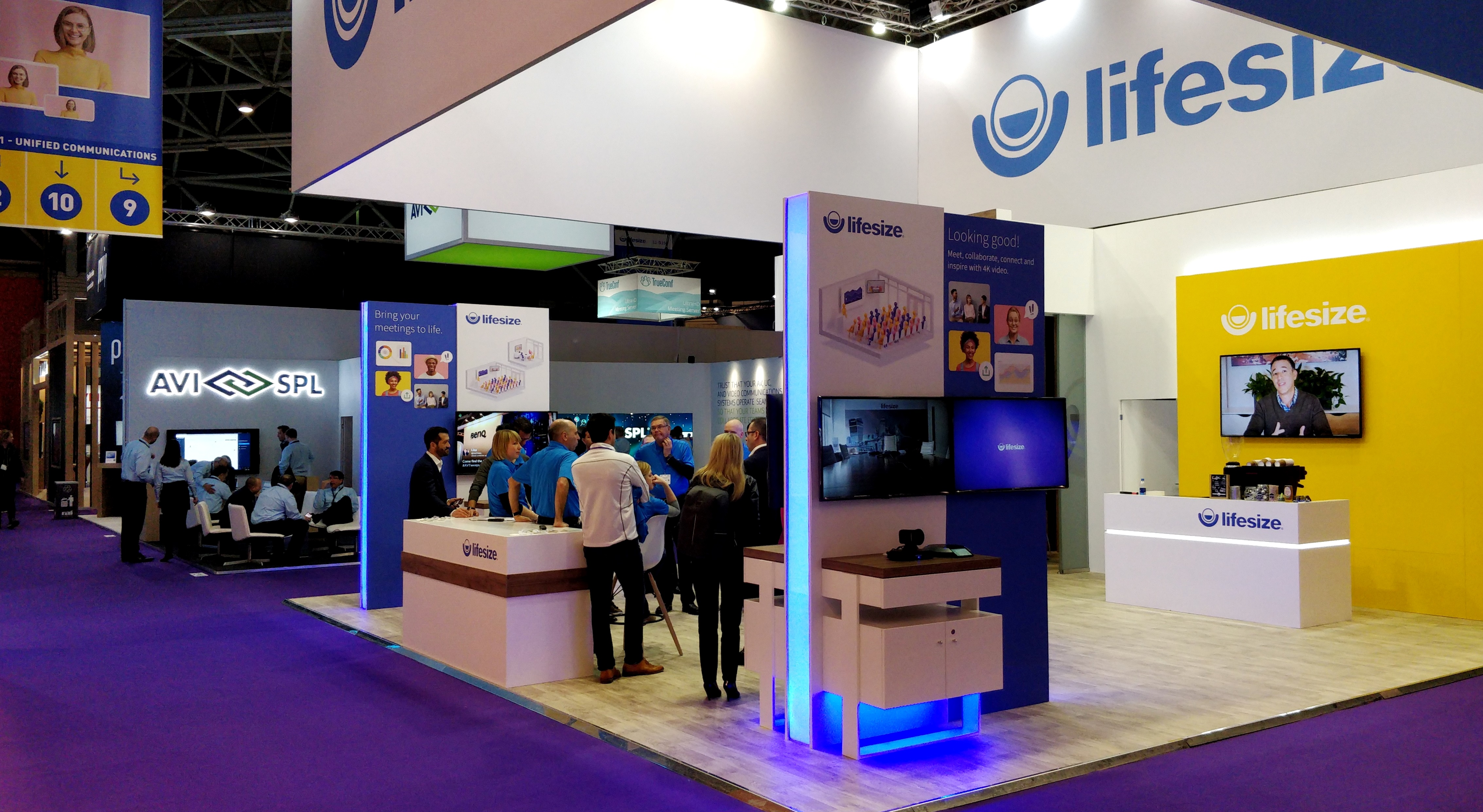
The reference point for the correct stand is the supermarket. Nothing should stop you from going inside, choosing a product, touching it and examining it. A minimum of obstacles at the entrance such as racks with handouts, reception tables, tables, chairs and other fortifications blocking the entrance. Everything should be easily accessible and enticing inside.
Design and construction of the stand
Some organizers offer a standard building from standard steel structures. Surely you have seen this at exhibitions, when people sit at the same tables around the perimeter in the same cells, whose stands differ only in name on the banner above their heads. It may be cheaper, but then your chances of attracting visitors are drastically reduced, you need to do something completely extraordinary to get noticed there. Such stands are often paid for by the state, associations, or somehow co-financed, so exhibitors are not the most motivated for business there. The guests feel it.
Development is needed for your specific needs... Demonstration of the product should be convenient, including from a technical point of view. To do this, it is necessary to correctly plan not only the space for the display, but also all the equipment connection points, the meeting area, storage space for fur coats, suitcases and nesting dolls with vodka for guests.
You need to decide whether you will build the stand yourself or hire professionals. If the construction of the stand falls entirely on the shoulders of your employees (do not do this), then you need to understand that the stand is not only walls and furniture, but also floors, hanging structures, electrics, light, low current, graphics and rented equipment. Abroad, for many works, documents are required confirming that you are a specialist and will not harm the health of exhibition visitors with your amateur performances (spoiler: this does not give you a guarantee of quality). On days of active development, you will not even be allowed to enter the site without a helmet and construction shoes. It's much easier to hire a contractor... For the contacts of the contractor, you can contact the organizers, but it will most likely be a pig in a poke, the easiest way is to find colleagues who have already traveled and ask them for a tip. This is how we found our developers.
Next, plan how and what you want to show your visitors . This needs to be thought through before you start adding beauty to walls and other surfaces with a designer. How many products and services you carry, how many demo zones you need to display them. There should be room for 3-5 spectators in front of each zone. It will not be superfluous to rent chairs so that you can relax yourself, as standing all day is not easy. Do not forget to provide a utility unit for personal belongings, clothes, wet umbrellas mixed with spare parts, extra wires and trash cans.
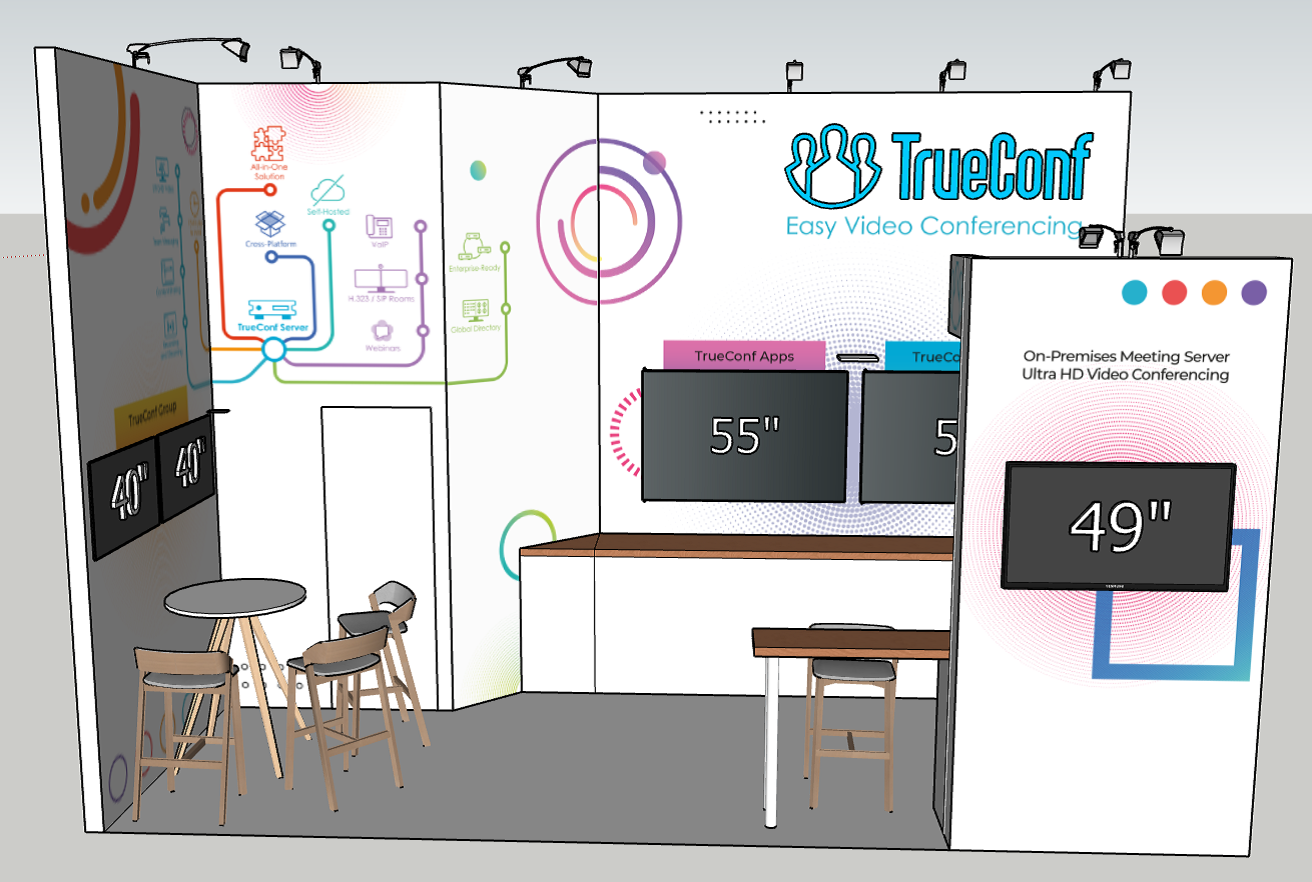

The way the finished stand looks like in your understanding, you bear to the designer. If the designer is your own, remember to match
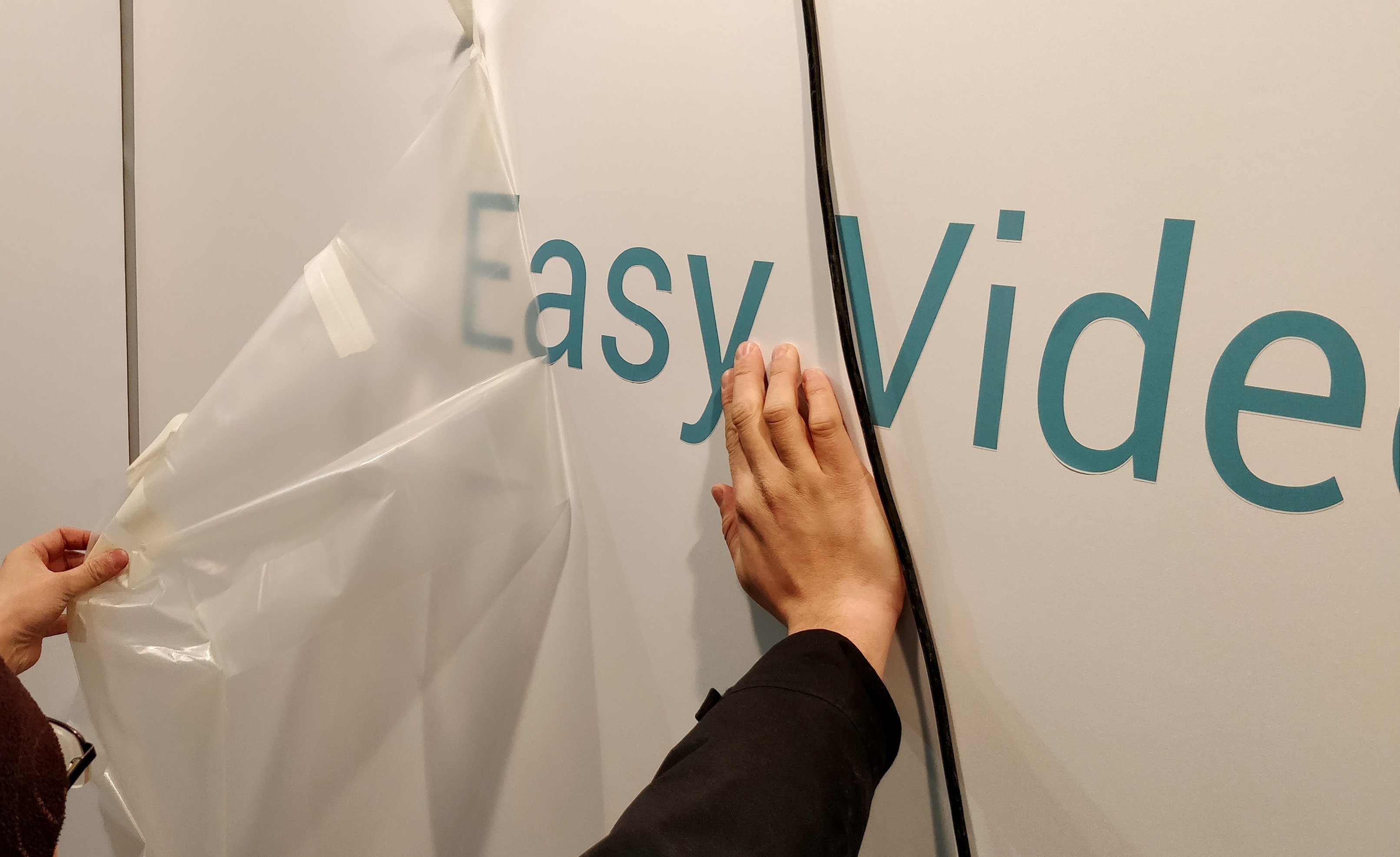
It is important to discuss absolutely everything with the developer, to include in the contract details up to the shape of the handles and the height of the carpet pile. Anything that can be done wrong will be done wrong. Not because this is hack or poor quality materials, but because you most likely have different expectations. The developer will not be able to guess your fantasies and will always strive to save money - this is his honest earnings. Be sure to save all correspondence just in case.
More subtleties to note
1. After concluding a contract with the organizers of the exhibition, you will receive a crazy document on 60 pages in small print. He describes the rules of participation, the order of building and the like. There, traditionally, in the middle there may be important terms for providing information, discount conditions, technical requirements. Read everything carefully, the sooner you study this document, the more money you can save. You can run into a fine if you don't agree on your stand layout in time. Or, at your own expense, in an emergency mode, make the back sides of your walls, which face your neighbors, look decent, if you build them above certain values.
Transportation of equipment
2. If you have a large, but common equipment such as a TV set, and tickets with transfers and other difficulties, it will be easier to rent it along with other furniture and waste bins through the exhibitor's personal account. But it's usually expensive. From personal experience: sometimes buying TVs / monitors is cheaper than renting them for 4 days. If suddenly someone you know needs a new TV, buy it on the spot in an electronics store and take it home with you. Aeroflot allows you to carry up to 203 cm in size as an additional piece of baggage for a reasonable price, and this TV is as much as 49 ".
3. If you need expensive equipment for one time, try asking the manufacturer for it for free. It is unlikely that he will be against once again to light up and demonstrate the capabilities of his product. Cisco, Logitech, Sennheiser have never refused us.
4. If you cannot do without transporting your equipment, then I recommend making Carnet ATA, which allows you to import and then return any exhibition equipment to most countries of the world. It is made in the Chamber of Commerce and Industry for 12-15 thousand rubles. There you will have to enter the serial numbers of each wire and piece of iron. A document is made for a week, but the customs officers of most countries of the world at the sight of this paper will immediately lose interest in you. There is a nuance - this does not work in the USA. There we sculpt Not for resale stickers on the devices, but we have not yet been able to make sure that they work, since no one is interested.
5. People carrying equipment should fly either direct flight or in advance to minimize the risks associated with delayed / lost baggage on connecting flights. If it is not possible to take the equipment with you or it is very bulky, then you will have to use the services of logistics companies. This is expensive and will still require a Carnet ATA.
Stand installation
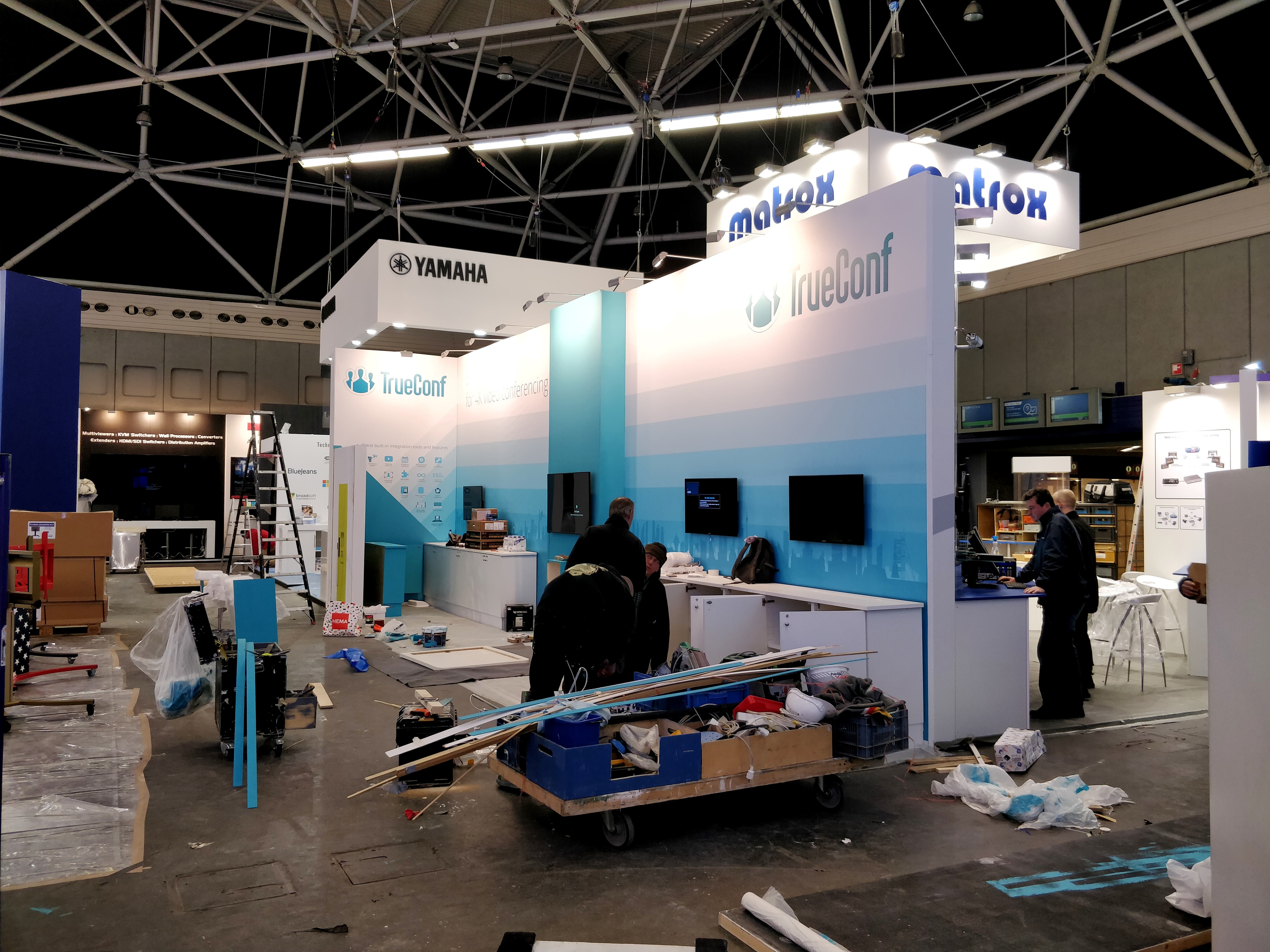
6. Exhibition - a toy city for a couple of days. Do not get hung up on too high-quality buildings and materials. Design features should not threaten visitors, you and the safety of equipment, the quality of the finish should not cause aesthetic complaints at a distance of about 2 meters, communications should fulfill their function. By the way, choose an inexpensive floor covering, but with a soft, thick backing. Visitors like to walk on it, and your feet will be grateful to you after 3-4 days of work standing at the stand.
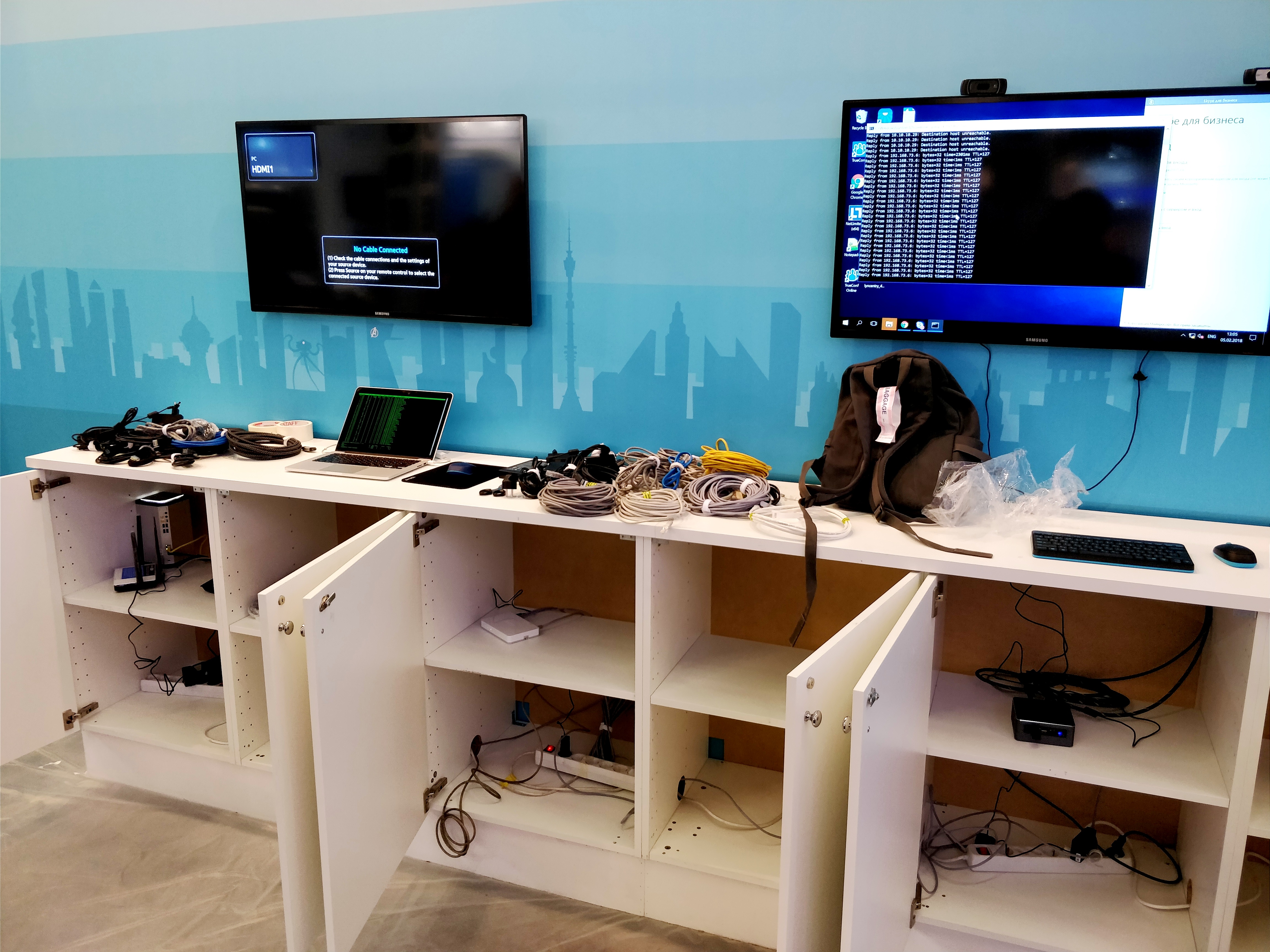
7. The equipment at the stand must be assembled by ourselves and everything must be carefully checked and rehearsed. Usually day -2 (this is when the exhibition is the day after tomorrow) goes to the acceptance of the stand from the developer. Therefore, it is necessary to immediately register in the contract that he will finish all his affairs no later than in the evening -2 days or in the morning of the last day before the exhibition. But day -1 (the day before) reserve the whole for the installation of your equipment and demos. Nobody canceled the overlays. I recommend placing markers on the map in advance at the nearest Mediamarkt, IKEA, Home Depot and other RadioShack. The site is often not allowed to stay at night, do not count on the last night before the opening, you can get a fine. We always mount a stand back in Russia in the mode "at the entrance only a 220V socket", we test for overheating and other technical nuances, we measure the cables of the required length,we take with us a supply of little things. It takes a whole working day to mount it again at the exhibition before opening.
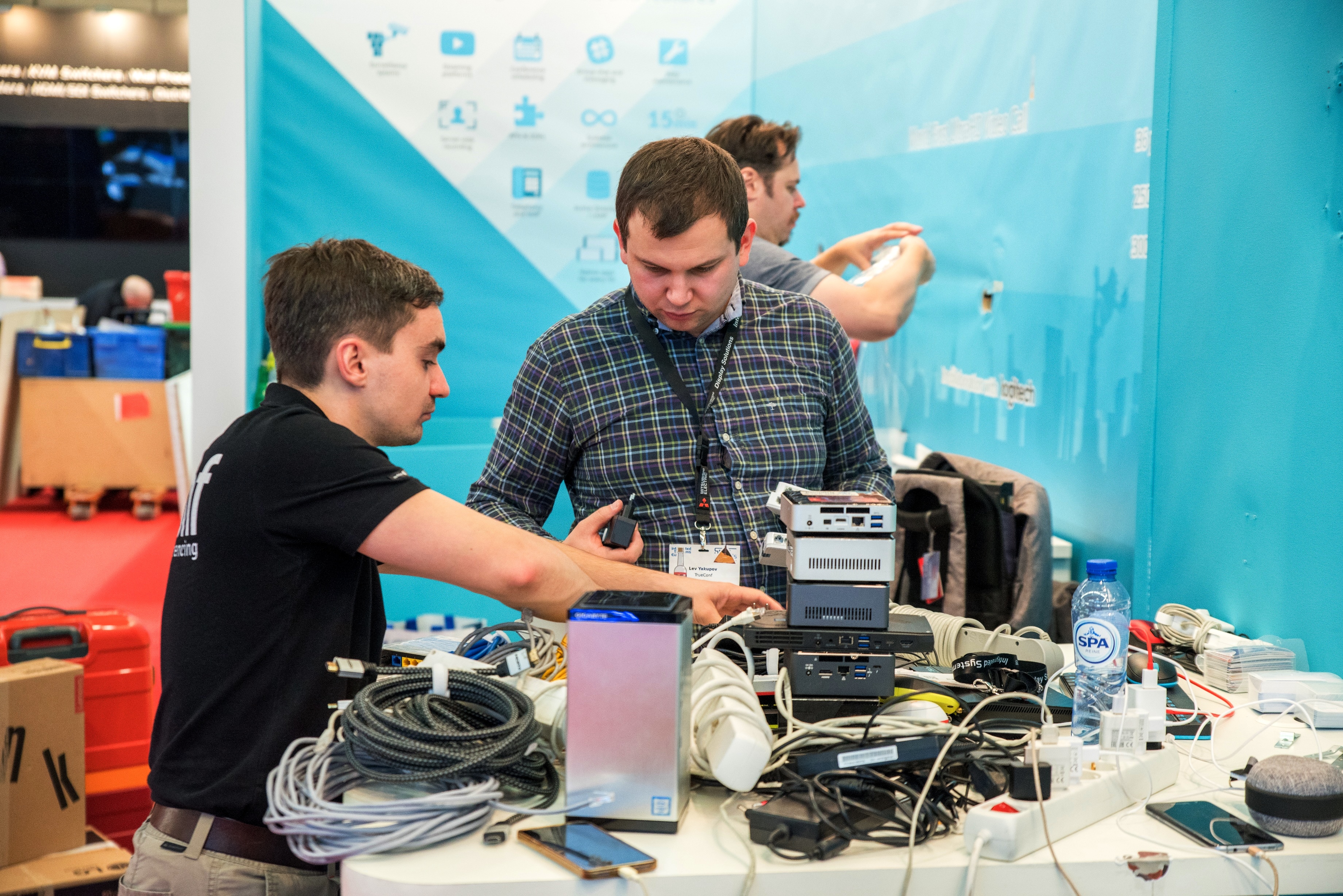
Communication with visitors
8. When ordering services, do not forget the badge scanner. This is not a device, but a paid application. It costs € 200-500 for a license, slightly more expensive in the USA. Put on any spare phone and enable unlocking by fingerprints or pin only for stand employees. Now you can scan all interested visitors and access their contacts without unnecessary complications. An internet connection is required to get full contact details from the host cloud. The exchange of paper business cards is still alive, but slightly outdated and requires the utmost concentration and motivation from all participants in the process. With the help of a scanner, we collect many times more contacts, plus several hundred.

9. Make your own business cards so that it is convenient to contact you. Add contacts in business social networks (LinkedIn) and instant messengers (WhatsApp).
10. If possible, do not stand at the stand with an aggressive combat detachment facing the hall, blocking your possessions, they will be afraid to approach you. Below is a bad example.
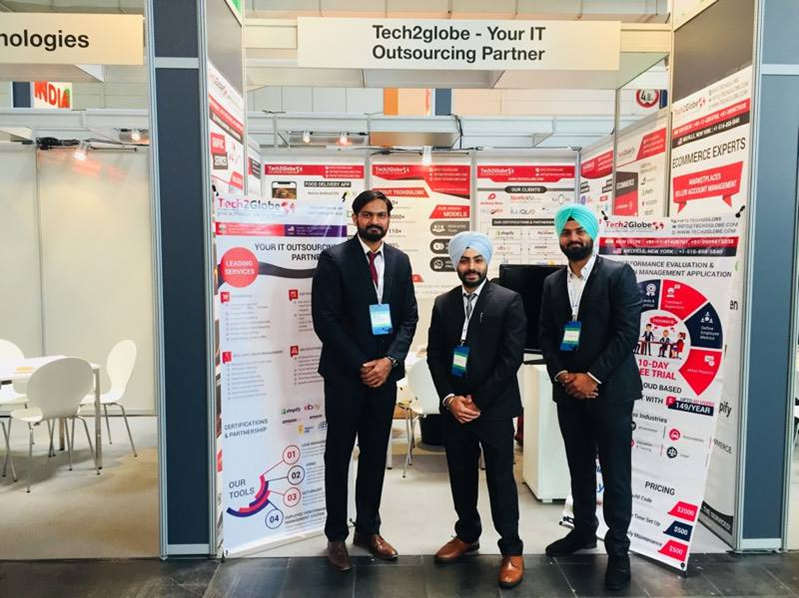
11. Don't forget to prepare handouts, small gifts and souvenirs for the booth guests. It is desirable that it be something useful that can be used regardless of your ads, otherwise they will very quickly end up in the trash can. Plan who gets lucky and how. We usually print everything in Russia and take it with us. It is cheaper and safer to pay Aeroflot 3,000 extra for an extra suitcase than to pay 30,000 to a logistics company.
12. Agree on how the stand and demo zones should look like by default. After the demonstration, each employee returns everything to their places so that his colleague can start communicating with the next visitor according to an already debugged script. This is really very important, since the equipment operates in show mode at the limit of its capabilities - 60fps instead of 30, 4K resolution instead of 1080p, and so on. Someone who is tech-savvy should be constantly on the lookout and ready to restart frozen demos and devices very quickly and return them to combat readiness.
13. Think over uniform clothing and / or footwear so that the staff at the stand would associate with your brand and look neat. Stock up on deodorants and breath fresheners.
14. There should be pills for headache and plenty of drinking water on the stand. The constant chatter dehydrates as quickly as a marathon runner.
15. Catering life hack: guests are happy to treat themselves to beer. You can give vodka, but in a volume of 50 ml. Everyone saves on luggage and just a physically large bottle cannot be brought through the airport control.
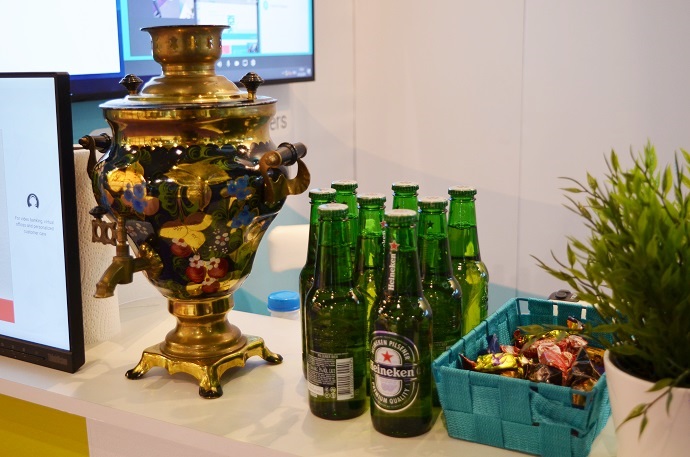
Let's go
An important point: who is driving . There is such a good tradition - to send employees to exhibitions, from whose absence the production process will not suffer much. Or honored directors and heads of departments. They just stand there and distribute / collect business cards, they can also scare away visitors with displeased gloomy faces and do not really explain anything.
You need to understand that participation in an exhibition is an important part of the very production process. The exhibition should be attended by people trained both from the point of view of knowledge about the product and from a psychological point of view, ready to chat with hundreds of people in a foreign language for hours. Since we are not in a fairy tale, let them be different people, but all these functions at the stand must be closed by someone, otherwise you will waste your money. Ideally, you will need 1 employee for every
If you are a beginner at an exhibition, no one will come up to you, you need to really get people out of the flow and pitch them. For this, many hire third-party promoters, devoid of any complexes. From experience, only 1 out of 5 captured visitors will be useless to you. There are few superfluous people at exhibitions.
You must also have a plan . Active search and collection of information.
1. This is the buzzword of networking. Before departure, check the list of exhibitors and select companies that are of interest to you. Make appointments in advance with helpful people using special services from the organizers or via LinkedIn. More useful negotiations can be held at an exhibition than in a year of traveling. Because all the necessary people are here and now, they are ready to consume new information and willingly make contact. This sounds absurd, but we hold a significant part of the meetings with Russian integrators in Amsterdam during four February days at ISE, and not in Moscow during the year. You will have only 3-4 evenings for drinking and treating your most important partners. And they too. Therefore, agree with them at least a month or two. In an exhibition, it is useless to invite someone to dinner day in and day out, usuallyall serious people have long been engaged.
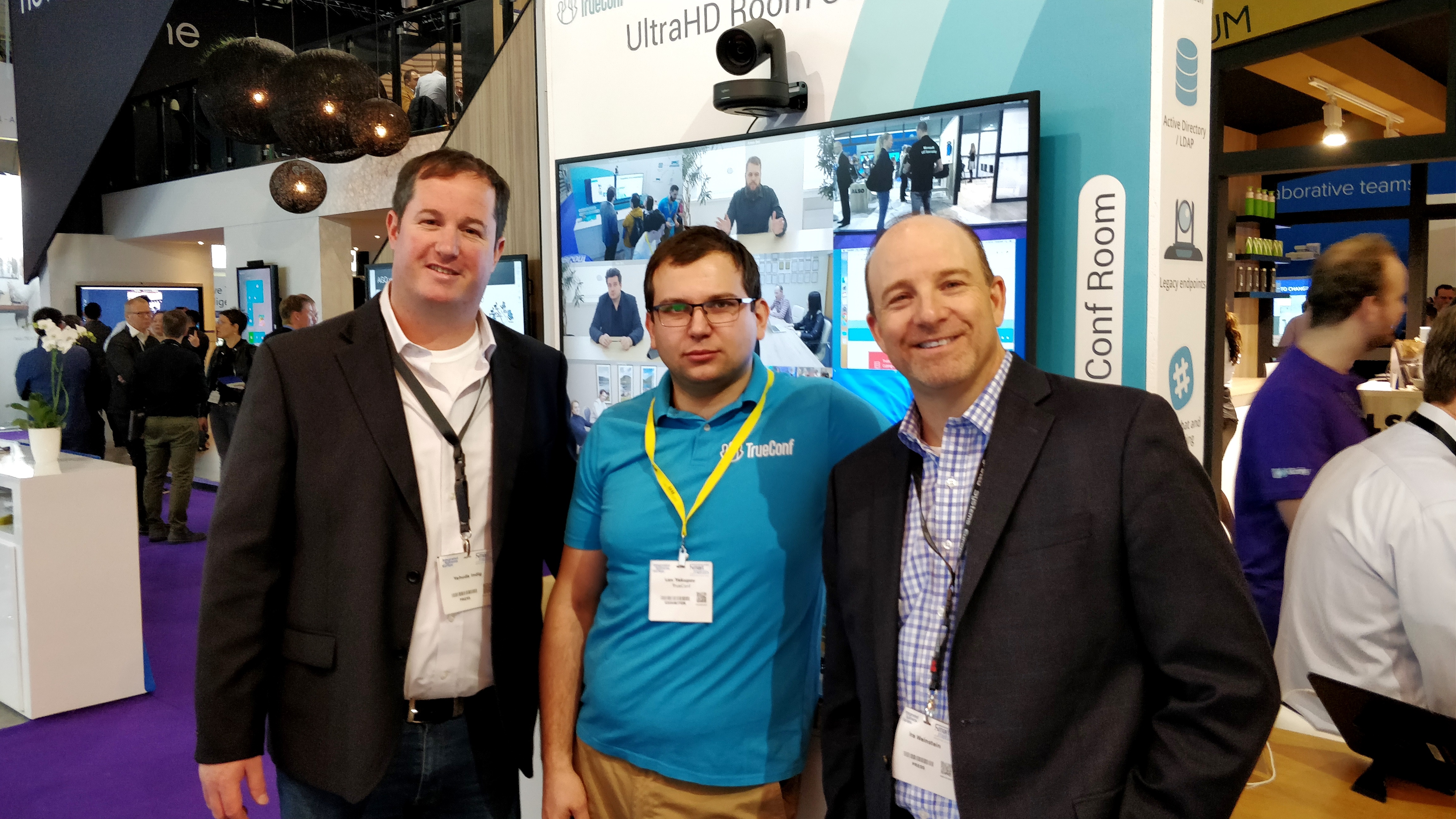 Our guest is the renowned analyst Ira Weinstein from Recon Research (right)
Our guest is the renowned analyst Ira Weinstein from Recon Research (right)
2. Prepare to meet with journalists. Press tours are specially made for them, they receive your press releases from the organizers in advance and can come in at any time to inquire about the novelty.
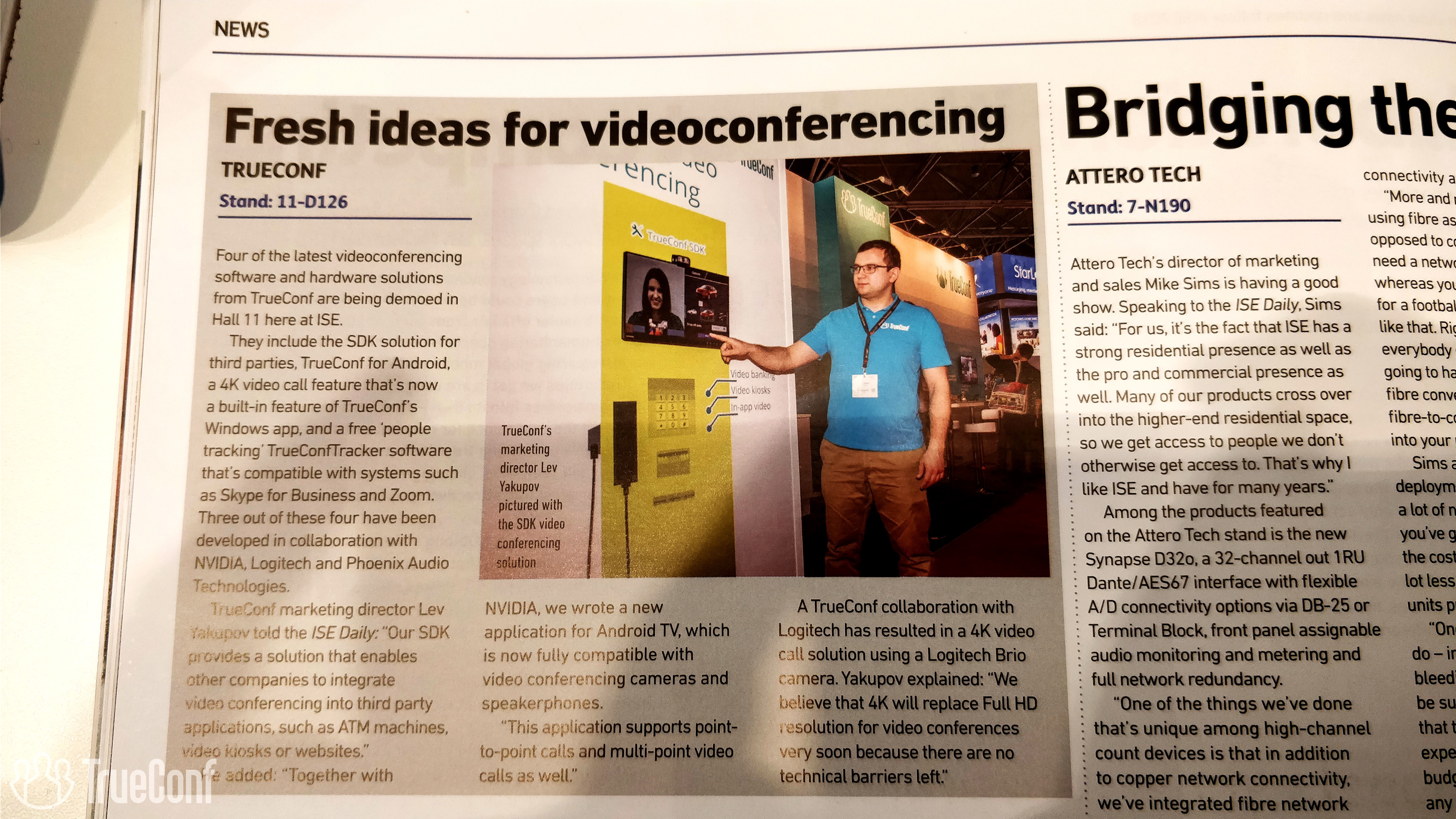
3. Separately, it is worth highlighting the competitors and go through them to see what they are betting on, how they position the product, what new features and functions are. A spare badge for another organization and a spy outfit will come in handy (that is, do not forget to change your branded uniform for casual clothes). You can introduce yourself as a journalist, it's easier for us, we have our own small news resource about video communication and everything related to it.
4. Study the activities that are held in parallel with the exhibition - all kinds of seminars, presentations, conferences. There you can speak and announce something. Sign up for informal events and parties, networking is key. Think about how else you can use the footage there and the information you heard. In addition to actual business ideas, it can be useful, for example, for a blog.
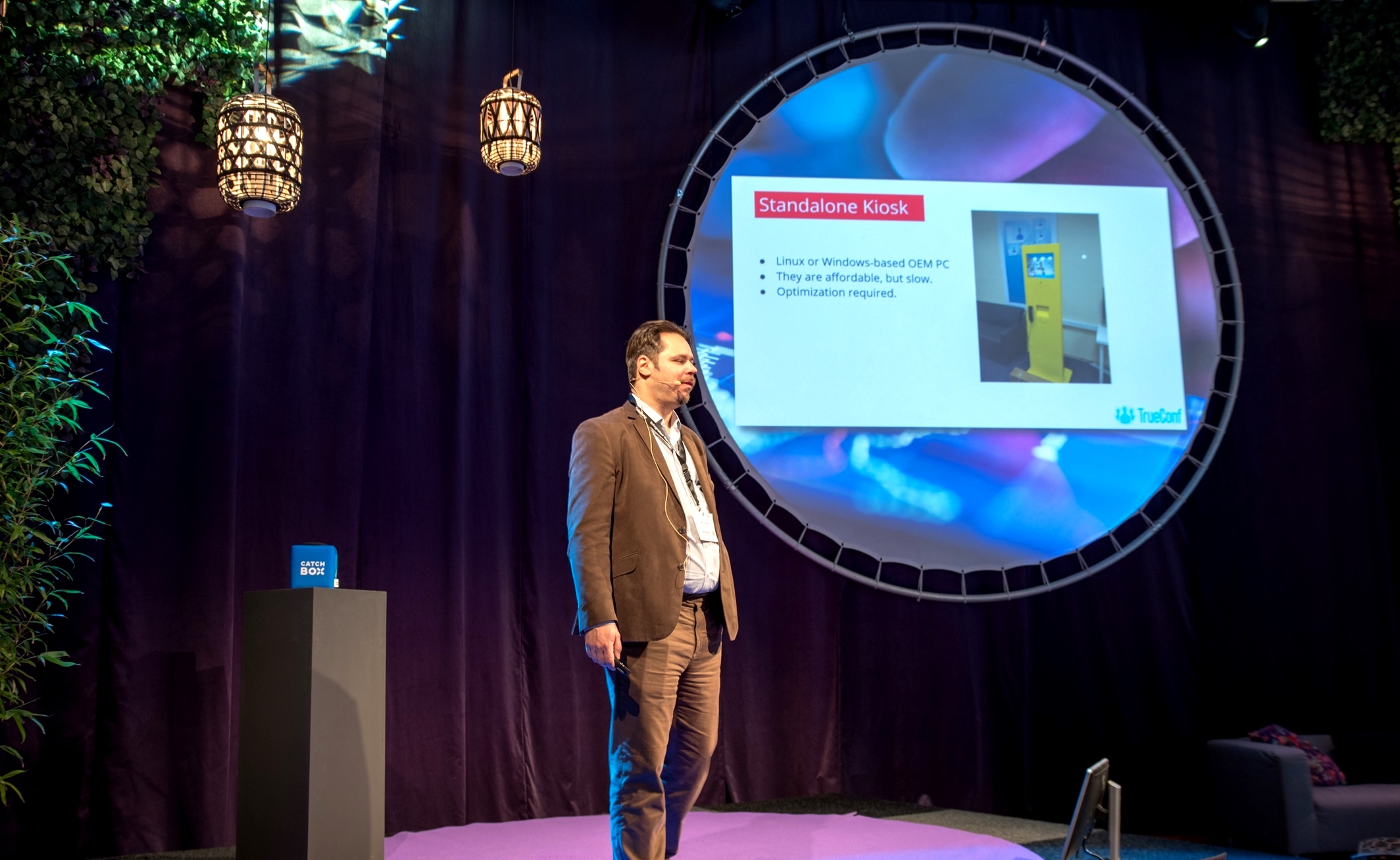
5. Appoint a conventional photographer in the team and provide him with the technique, so that later it would not be excruciatingly painful to remember what happened after all. If he is going to shoot on his phone, check before leaving that you are satisfied with the images received from this particular device and made by this particular person.
Since this is a plan, it will be convenient to schedule it by day and assign responsibilities. For someone to take pictures (and not under the curtain, when everyone has already dismantled their stands and dispersed), and someone who understands at this time studied the competitors. Moreover, your own stand should not be empty due to the fact that everyone went to the front.
Profit
We usually count the number of contacts that we managed to develop at the exhibition. It is possible to collect them under a thousand. It is important to update new acquaintances immediately after the end of the event, without shelving, Linkedin will help you. Otherwise, half of the people you just have time to forget, as they do you. We monitor the fact of the conclusion of any partnership agreements with established contacts within a year after the exhibition.
By the way, it makes sense to process all the information received during the exhibition day and put it on the shelves on the same evening. This good hygiene habit saves a lot of time and thought in clearing up debris after a weeklong event.
Contacts of partners can be immediately thrown off to people who will work with them. We take pictures of all business cards at the end of the day and send them to colleagues in Moscow for digitization and addition to CRM. For each scanned badge, we write a comment for the operator on the mainland: what product he was interested in, what competitors were asked to compare with, and so on.
All ideas must be written down immediately in a piggy bank so as not to forget. Or confuse them with someone who thinks them over in a more relaxed environment. You may have time to plan for the remaining days of meetings / activities for new injections.
Other bonuses that can be obtained from an ideal spherical exhibition in a vacuum, if you prepare well and have time for everything:
- Evaluating the market reaction to your product, testing hypotheses.
- Demonstration to the market of its combat capability and relevance.
- Valuable information about what they are proud of and how competitors position themselves, where the wind blows globally.
- Clarification in the process of preparation for the exhibition of their own goals and expectations, adjustment of positioning.
- Employee motivation and upgrade, team building.
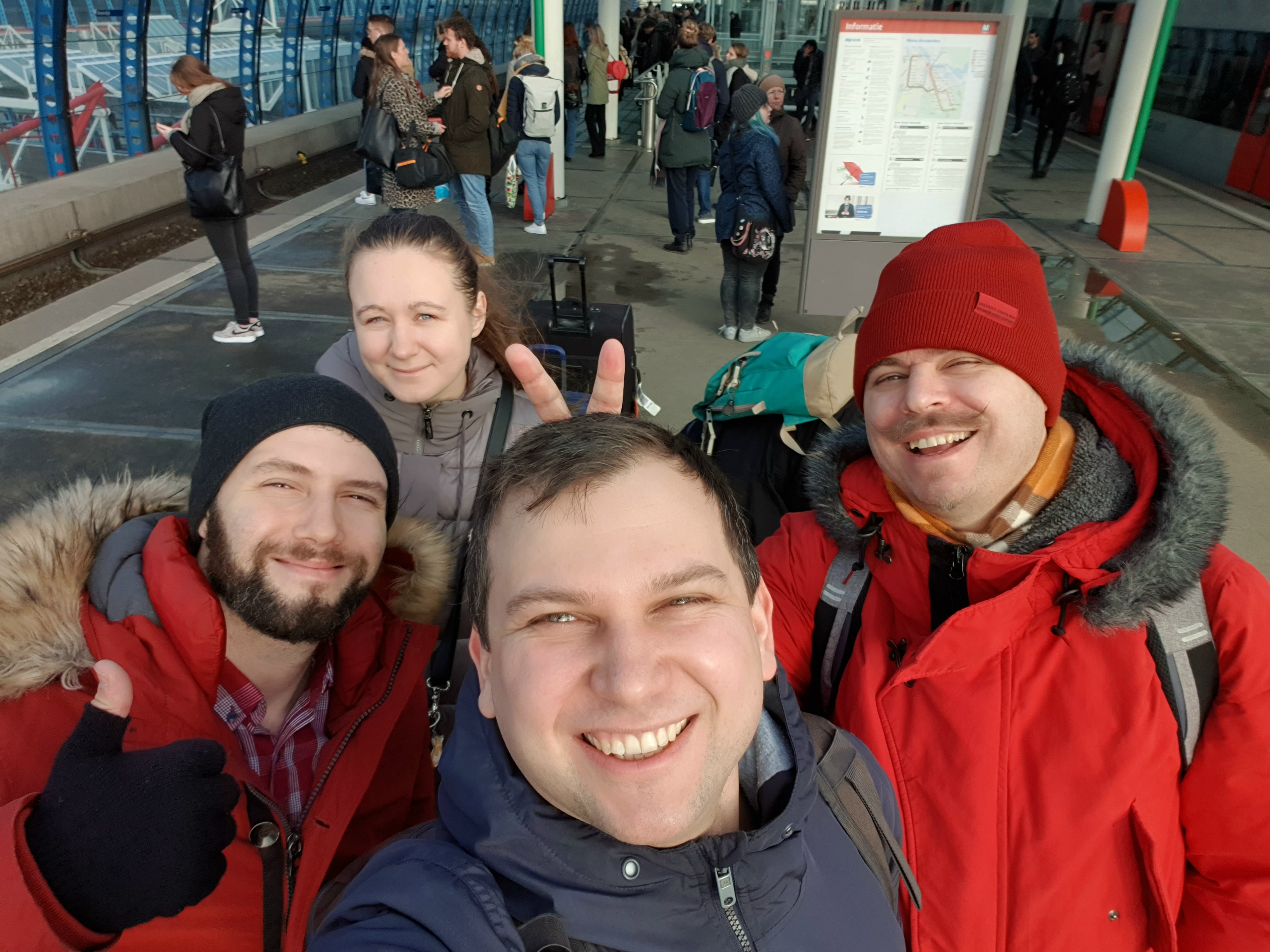
No other effective ways to get people out of their cozy little worlds and routine have yet been invented, so exhibitions are unlikely to fade into oblivion in the near future. So long live offline and go for it!